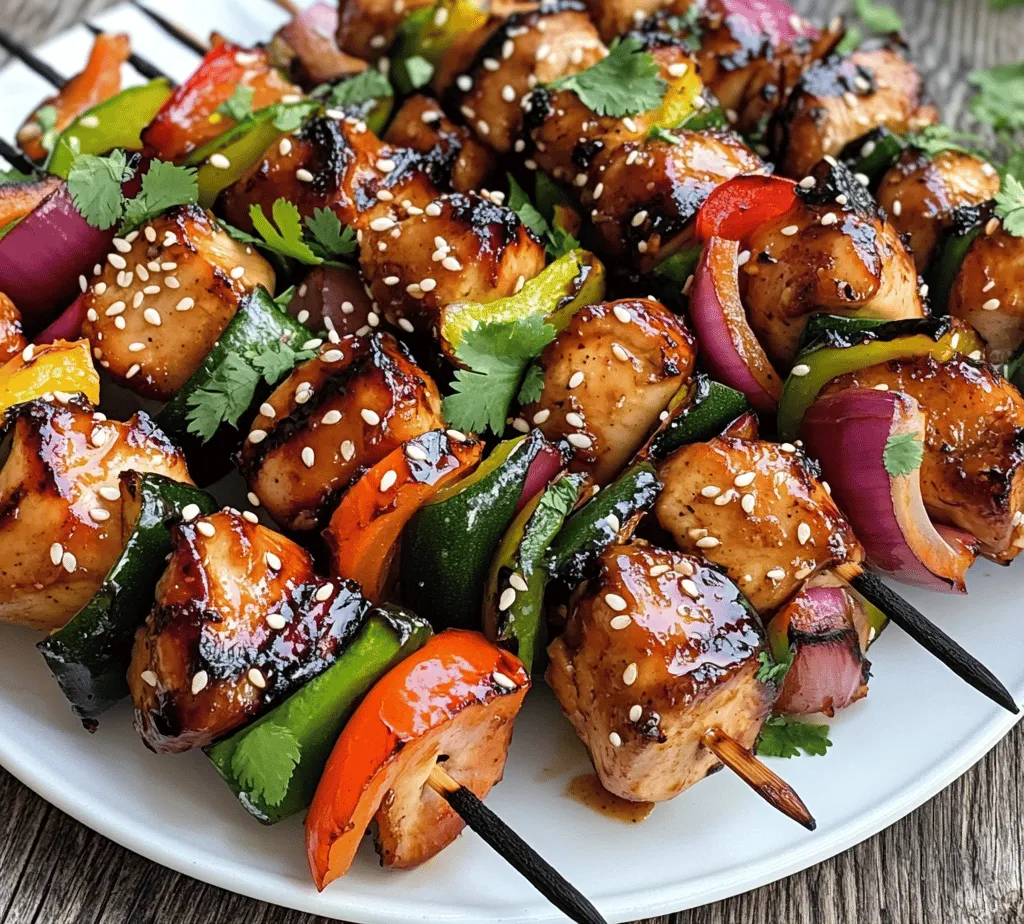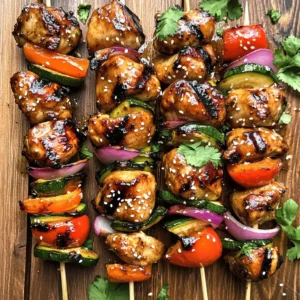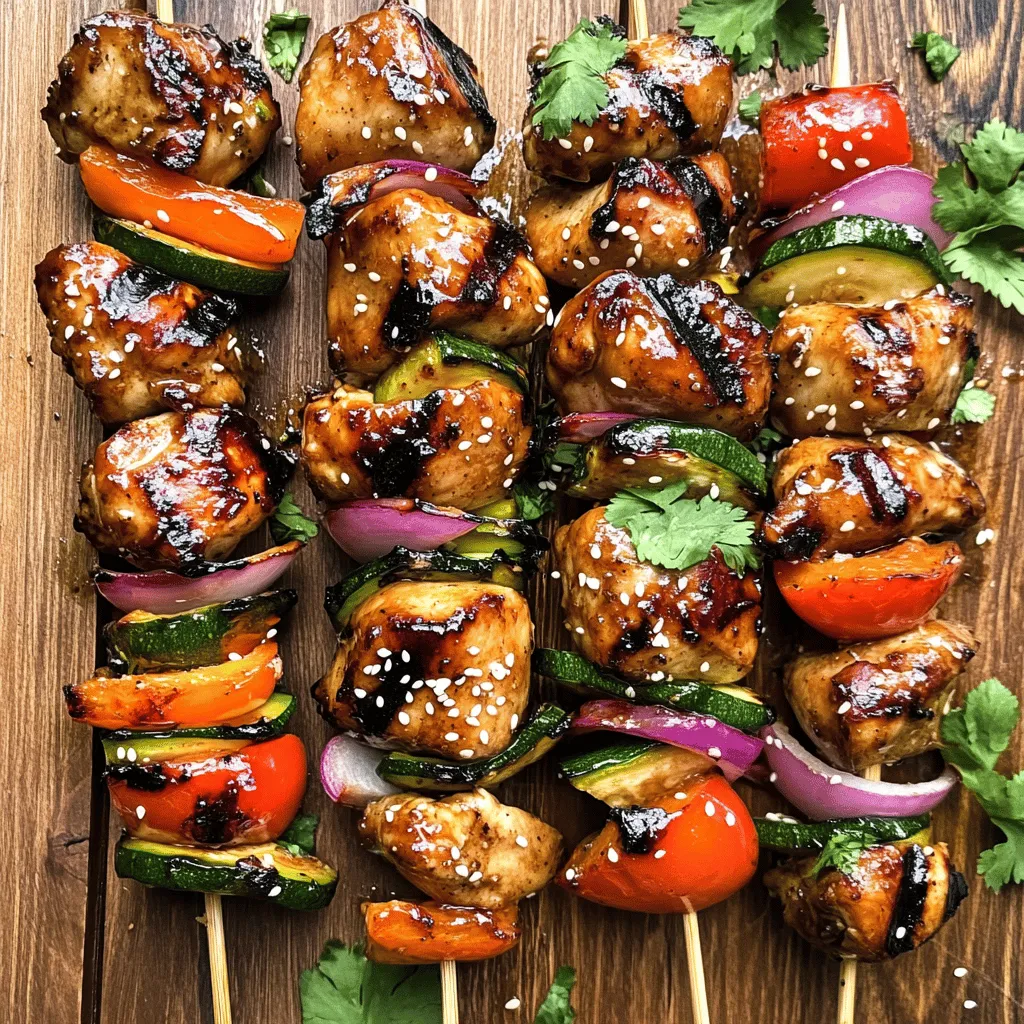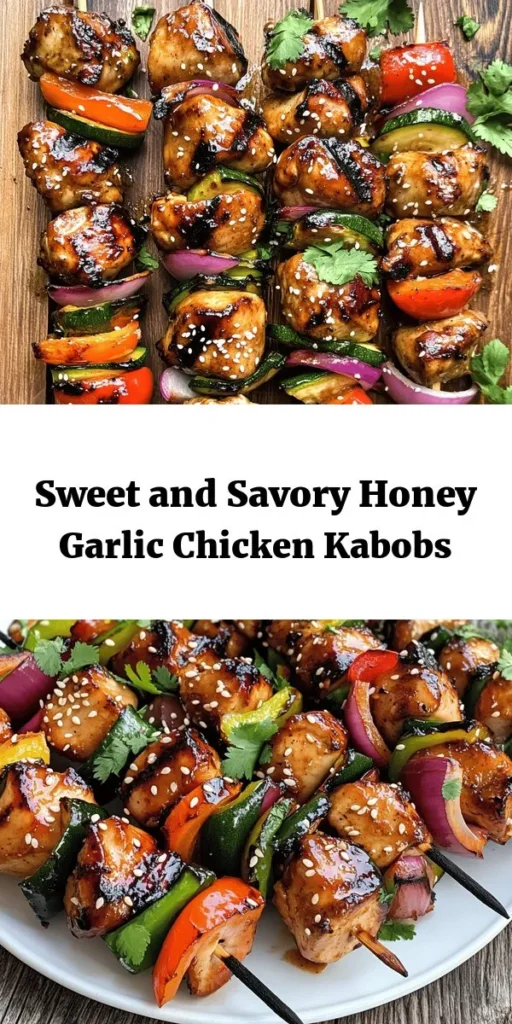The allure of a summer barbecue is hard to resist, especially when it involves the tantalizing flavors of Honey Garlic Asian Chicken Kabobs. This dish marries the sweetness of honey with the savory notes of soy sauce, creating a delightful marinade that elevates tender chicken thighs. Perfect for gatherings or a cozy family dinner, these kabobs are not only visually appealing but are also a breeze to prepare. In this article, we will explore the step-by-step process of creating these delicious kabobs, along with insights on ingredients, cooking techniques, and serving suggestions.
Understanding the Ingredients
Chicken Thighs: The Ideal Choice
When it comes to making kabobs, the choice of meat is crucial. For our Honey Garlic Asian Chicken Kabobs, boneless chicken thighs are preferred over chicken breasts for several reasons. Firstly, chicken thighs are known for their rich flavor and juiciness, which makes them ideal for grilling. The dark meat retains moisture better than white meat, ensuring that your kabobs are succulent and tender, even after being cooked over high heat. Additionally, the higher fat content in chicken thighs allows for a more robust flavor profile, which beautifully complements our sweet and savory marinade.
Using boneless chicken thighs also streamlines the preparation process. They are easy to cut into uniform pieces, ensuring even cooking on the grill. If you are looking to create kabobs that are both delicious and satisfying, opting for chicken thighs is a decision you won’t regret.
The Sweet and Savory Marinade
The marinade is where the magic happens, transforming simple chicken into a culinary masterpiece. Our Honey Garlic Asian marinade includes a harmonious blend of ingredients that work together to create a rich flavor profile. Here’s a closer look at each component:
– Honey: The star of the show, honey adds a natural sweetness that caramelizes beautifully when grilled, creating a delightful glaze on the chicken.
– Soy Sauce: This ingredient introduces umami, deepening the overall flavor and providing a salty contrast to the sweetness of the honey.
– Garlic: Fresh minced garlic contributes a pungent aroma and taste that elevates the dish, infusing it with a savory richness.
– Ginger: Adding a hint of warmth and spice, ginger balances the sweetness of the honey, enhancing the marinade’s complexity.
– Rice Vinegar: A splash of rice vinegar adds acidity, brightening the flavors and cutting through the richness of the chicken.
– Sesame Oil: A drizzle of sesame oil introduces a nutty flavor, characteristic of Asian cuisine, and enhances the overall depth of the marinade.
– Chili Flakes: For those who enjoy a bit of heat, chili flakes can be added to the marinade, giving the kabobs a spicy kick that complements the other flavors.
When combined, these ingredients create a marinade that not only tenderizes the chicken but also infuses it with layers of flavor, making every bite a delicious experience.
Color and Nutrition from Vegetables
No kabob is complete without colorful vegetables, which not only enhance the visual appeal but also add nutritional benefits. For our Honey Garlic Asian Chicken Kabobs, we recommend using a combination of bell peppers, red onion, and zucchini.
– Bell Peppers: Available in a variety of colors, bell peppers add sweetness and crunch. They are also rich in vitamins A and C, making them a healthy addition to your dish.
– Red Onion: With its slightly sweet and tangy flavor, red onion adds depth and color to the kabobs. It is also packed with antioxidants and can contribute to heart health.
– Zucchini: Zucchini is a versatile vegetable that absorbs flavors beautifully. It adds moisture and texture to the kabobs, while also being low in calories and high in fiber.
Incorporating these vegetables not only enhances the flavor of your kabobs but also increases their nutritional value, making your meal more balanced and wholesome.
Preparing the Marinade
With a clear understanding of the ingredients, it’s time to create the marinade that will take your chicken kabobs to the next level.
Step-by-Step Marinade Creation
1. Gather Your Ingredients: Start by measuring out all the marinade components: honey, soy sauce, minced garlic, grated ginger, rice vinegar, sesame oil, and chili flakes. Having everything ready will streamline the process.
2. Whisking Together: In a medium-sized mixing bowl, combine the honey and soy sauce. Use a whisk to blend these two together until they form a smooth mixture.
3. Adding Aromatics: Next, add the minced garlic and grated ginger to the bowl. Continue whisking until the garlic and ginger are evenly distributed throughout the marinade.
4. Incorporate Acidity and Flavor: Pour in the rice vinegar and sesame oil, whisking again to combine all the flavors. Finally, sprinkle in the chili flakes if you desire some heat. Taste the marinade and adjust the sweetness or saltiness to your preference by adding more honey or soy sauce.
5. Achieving Balance: The key to a great marinade is balance. You want a harmonious blend of sweet, salty, and savory. If the mixture is too sweet, a bit more soy sauce can help; if it’s too salty, add a touch more honey or a splash of water.
Now that your marinade is ready, it’s time to move on to marinating the chicken.
Marinating the Chicken
Marinating is a crucial step that allows the chicken to absorb all the wonderful flavors from the marinade. Here’s how to do it effectively:
1. Preparing the Chicken: Start by cutting the boneless chicken thighs into uniform pieces, about 1 to 1.5 inches in size. This ensures even cooking on the grill.
2. Combining with Marinade: Place the chicken pieces in a resealable plastic bag or a glass bowl. Pour the prepared marinade over the chicken, ensuring all pieces are coated evenly.
3. Sealing and Refrigerating: If using a bag, seal it tightly, removing as much air as possible. If using a bowl, cover it with plastic wrap. Place the marinated chicken in the refrigerator.
4. Recommended Marination Times: For optimal flavor, allow the chicken to marinate for at least 30 minutes. However, for best results, marinating for 2 to 4 hours is recommended. This extended time allows the flavors to penetrate the meat, making it more flavorful and tender.
5. The Effects of Marination: The longer you marinate the chicken, the more pronounced the flavors will be. Just be cautious not to marinate for too long (over 12 hours) as the acidity can begin to break down the chicken, resulting in a mushy texture.
Preparing the Skewers
With the chicken marinating beautifully, it’s time to prepare the skewers for grilling. The choice of skewers can significantly impact your kabob-making experience.
Choosing the Right Skewers
When it comes to skewering your chicken and vegetables, you have two primary options: wooden and metal skewers. Each has its pros and cons, and understanding these can help you choose the right type for your kabobs.
– Wooden Skewers: These skewers are popular for their affordability and ease of use. They are lightweight and can hold a good amount of food. However, they need to be soaked in water for at least 30 minutes before grilling to prevent them from burning on the grill. Soaking not only prolongs their life on the grill but also helps to steam the food slightly, ensuring it cooks evenly.
– Metal Skewers: While they may be slightly more expensive, metal skewers are reusable and do not require soaking. They conduct heat better, which can help with even cooking. However, they can be hot to handle, so be sure to use tongs or wear heat-resistant gloves when grilling.
Ultimately, the choice of skewers comes down to personal preference. Both options will yield delicious kabobs, so choose what works best for you and your grilling style.
With your marinade prepared, chicken marinating, and skewers ready, you are well on your way to creating mouthwatering Honey Garlic Asian Chicken Kabobs that will impress your family and friends alike. Stay tuned for the next part, where we will delve into the grilling process and provide tips for achieving the perfect kabob.

How to Assemble the Kabobs
Assembling your Honey Garlic Asian Chicken Kabobs is an exciting part of the cooking process that allows for creativity and presentation. Here are some essential tips for threading your chicken and vegetables onto the skewers effectively, ensuring each kabob is not only delicious but visually appealing.
Tips for Threading Chicken and Vegetables onto the Skewers
1. Choose the Right Skewers: If you’re using wooden skewers, soak them in water for at least 30 minutes before grilling. This prevents them from burning. Metal skewers are a great reusable option and do not require soaking.
2. Cut Uniform Pieces: For even cooking, cut the chicken and vegetables into uniform sizes. Aim for pieces that are about 1 to 1.5 inches thick. This will help ensure that everything cooks at the same rate.
3. Alternate Ingredients: Create a beautiful pattern by alternating chicken pieces with colorful vegetables. Bell peppers, red onions, and zucchini not only add flavor but also create a vibrant presentation.
4. Leave Space Between Pieces: Avoid overcrowding the skewers. Leave a little space between each piece to allow for proper heat circulation. This will help the kabobs cook evenly and achieve a nice char.
5. Secure the Ingredients: Push the ingredients snugly onto the skewer but not too tight. If they are too densely packed, they won’t cook properly. A little space allows for steam and heat to circulate.
Suggestions for a Colorful and Appealing Presentation
To elevate the visual appeal of your kabobs, consider using a variety of colored vegetables such as yellow squash, cherry tomatoes, and even pineapple for a sweet twist. You can also arrange them on a large platter in a rainbow pattern, which makes for an inviting presentation at gatherings.
Cooking the Kabobs
Prepping the Grill
Before you get to the fun part of grilling, it’s essential to prepare your grill properly to achieve the best results.
1. Preheat Your Grill: Whether you’re using a gas grill or a charcoal grill, preheating is crucial. For gas grills, set it to medium-high heat and allow it to preheat for about 10-15 minutes. If using charcoal, wait until the coals are covered with gray ash, indicating they are ready for grilling.
2. Clean the Grill Grates: A clean grill is key to preventing sticking. Use a grill brush to scrub off any leftover residue from previous grilling sessions. This not only helps with sticking but also enhances the flavor of your kabobs.
3. Oil the Grates: Lightly oil the grill grates with a paper towel dipped in vegetable oil or use a non-stick grilling spray. This adds a layer of protection between the food and the grates, making it easier to turn the kabobs.
Best Practices for Grilling Kabobs to Perfection
1. Space the Kabobs Apart: Once the grill is ready, place the kabobs on the grill, leaving space between each one. This allows the heat to circulate and ensures an even cook.
2. Turn Regularly: Grill the kabobs for about 10-15 minutes, turning every 3-4 minutes. This ensures that every side gets that delicious char and prevents burning.
3. Monitor the Temperature: Use a meat thermometer to check the doneness of the chicken. The internal temperature should reach 165°F (75°C) for it to be safe to eat.
Grilling Techniques
1. Cooking Times and Temperatures: As a general rule, chicken kabobs should cook for about 10-15 minutes over medium-high heat. Vegetables may take a little less time, so keep an eye on them to prevent overcooking.
2. Signs to Look for to Ensure the Chicken is Fully Cooked: Check for clear juices running from the chicken, and the meat should be opaque without any pink in the center. If using a thermometer, as mentioned, aim for 165°F.
Adding Finishing Touches
Enhancing Flavor with Extra Marinade
To take your kabobs to the next level, consider brushing them with additional marinade towards the end of the cooking process.
1. When to Brush on Leftover Marinade: About 5 minutes before the kabobs are finished grilling, brush them lightly with any leftover marinade. This will enhance the flavor and create a shiny finish.
2. Importance of Allowing Kabobs to Rest Before Serving: Once off the grill, let the kabobs rest for about 5 minutes. This allows the juices to redistribute throughout the chicken, keeping it moist and flavorful.
Serving Suggestions
Ideal Pairings for Honey Garlic Kabobs
To create a well-rounded meal, consider these side dish recommendations that pair beautifully with Honey Garlic Asian Chicken Kabobs.
1. Steamed Rice: A simple bowl of jasmine or basmati rice serves as a perfect base to absorb the savory flavors of the kabobs. You can also serve fried rice for an added texture.
2. Fresh Salads: A crisp cucumber salad or a mixed green salad with a light vinaigrette balances the richness of the kabobs. Add some sliced avocado or mandarin oranges for a refreshing touch.
3. Grilled Vegetables: Enhance the kabob experience with additional grilled veggies such as asparagus, corn on the cob, or even grilled eggplant. These provide complementary flavors and textures.
Creative Ways to Serve Kabobs for Gatherings
1. Kabob Bar: Set up a kabob bar where guests can assemble their own kabobs with various proteins, vegetables, and sauces. This interactive experience is sure to be a hit at parties.
2. Skewer Presentation: Instead of serving the kabobs on a plate, consider standing them upright in a container filled with rice or beans for a unique presentation. This not only looks impressive but keeps the kabobs secure.
Garnishing for Presentation
The finishing touches are what truly elevate your kabobs. Here are some garnishing ideas to make your dish pop visually.
1. Suggested Garnishes: Sprinkle some sesame seeds over the kabobs for a nutty flavor and a touch of crunch. Fresh cilantro and chopped green onions add a burst of color and freshness.
2. The Importance of Visual Appeal in Culinary Presentation: A beautiful presentation not only makes the dish more appetizing but also enhances the dining experience. Take a moment to arrange your kabobs artfully on a platter, and don’t shy away from using vibrant garnishes.
Conclusion
Honey Garlic Asian Chicken Kabobs are a delightful fusion of flavors that bring excitement to any meal. With their easy preparation and beautiful presentation, they are sure to impress family and friends alike. By understanding the ingredients and following the detailed steps outlined in this article, anyone can recreate this dish in their own kitchen. Enjoy the process of cooking and the delicious results that come with it, making every meal a memorable occasion. Whether you’re grilling for a casual weeknight dinner or hosting a weekend barbecue, these kabobs are the perfect addition to your culinary repertoire. Dive into the flavors and let each bite transport you to a place of culinary bliss.



